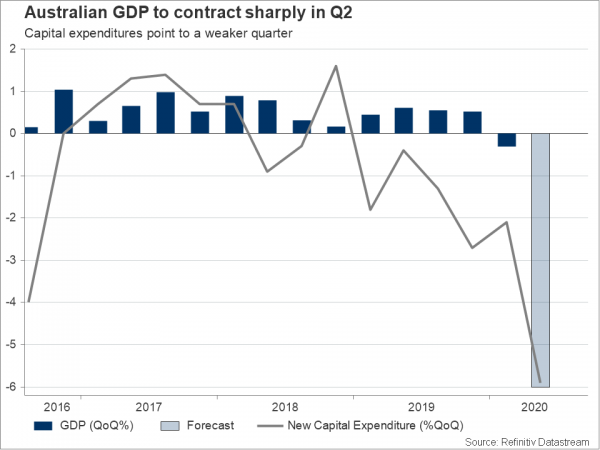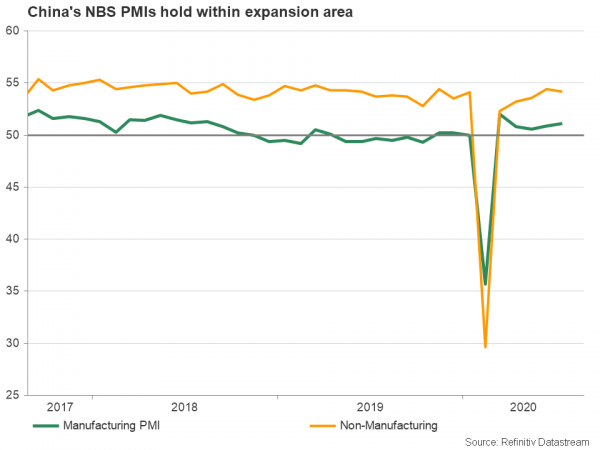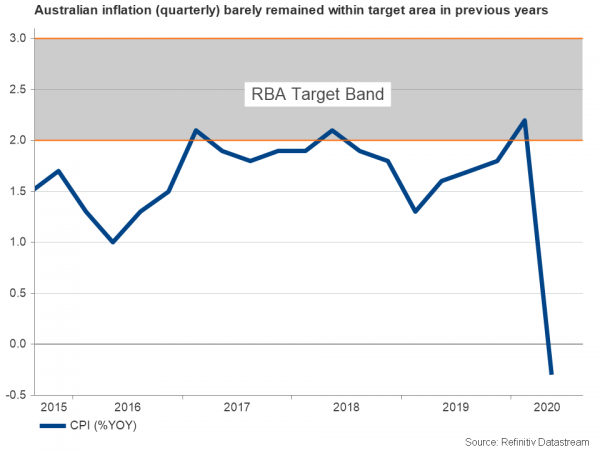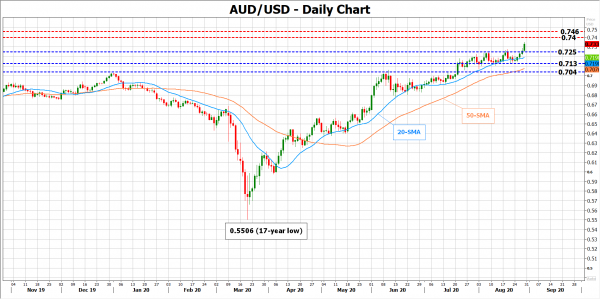Australia has two key events next week in the agenda. The Reserve Bank is setting its policy on Tuesday at 03:30 GMT, while the next day at 01:30 GMT the Bureau of Statistics is releasing GDP figures for the second quarter. Market analysts are expecting the central bank to stand pat even if the economy potentially shows a steeper contraction in Q2. Yet, whether the aussie will continue its rally may depend on how dovish the statement will be given the recent virus resurgence. Meanwhile, PMI data out of China on Monday at 01:00 GMT could determine whether the currency can have a green start to the week.
A sharper contraction in Q2 may not be a big surprise
The aussie managed to complete a clear V-shaped recovery against the US dollar in five months and register new 2020 highs above the 0.7400 level on Friday as the political noise and the resurgence in new Covid-19 cases in the US discouraged interest in the greenback.
It is not that Australia did not face a bounce in the number of infections. In fact, it did experience a second wave of the pandemic. Daily new cases increased exponentially to fresh peaks during the month of July, particularly in the key states of Victoria and New South Wales, forcing the government to shut parts of the economy and tighten restrictions on movements just after the country emerged from the first lockdown in June.
It’s likely that the resurgence in infections has further squeezed the economy in the third quarter and the Reserve Bank of Australia (RBA) will not forget to highlight the downside risks to the economy when it meets on Tuesday to assess its policy. The unemployment rate inched up for the third consecutive month to 7.5% in July and the consumer price index turned negative for the first time in the survey’s history in Q2, disrupting the RBA’s dual mandate of price stability and full employment. Last week, new capital expenditures data for the three months to June printed the fastest decline in investment in five years, and the negative construction figures further convinced economists that GDP figures in Q2 due on Wednesday may reveal a 6.0% quarterly contraction versus the softer 0.3% downfall in Q1. On a yearly basis, GDP is forecast to plummet by 5.3% after rising at a slower pace of 1.4% in the preceding quarter. That would be the first annual economic contraction in decades.
Why monetary policy will not change next week
Well, negative interest rates remain in the toolbox for difficult times but currently such a decision would only damage foreign investment, which has been prominent to Australia’s growth for many decades now. Specifically, Australia is providing higher interest rates (0.25%) than the US is doing now along with New Zealand and Canada and that makes it an attractive destination for foreign investment. Of course, a drop in rates would bring downside pressures to the aussie and thus benefit exporters, though as long as there are other means to depreciate a currency and keep competitiveness in international markets, the central bank could avoid that strategy. The yield curve control aimed at keeping three-year yields at 0.25% has been implemented in March for that purpose.
Intervening in exchange markets could be another way, though according to the central bank this would be more effective if the aussie was out of step with fundamentals. For now, Australia’s major export iron ore is trading at a higher price, which is helping the aussie, while demand from its major trade partner, China, has been strengthening recently despite political tensions between the countries. At this point it is also worth noting that the Chinese manufacturing PMI index published by the National Bureau of Statistics is forecast to tick up to 51.2 from 51.1. Even though this is not a big improvement, it is still above the 50 level that separates growth from contraction and hence it is positive for the aussie. The currency could have a green start to the week if the Chinese PMI surprises to the upside.
Adopting more flexible inflation targeting could turn to be a popular tool for holding rates low for longer nowadays. The Fed came first on Thursday to say that it would allow inflation to rise above its 2.0% target for some period of time, without increasing rates. Other central banks have been examining that case too before Covid-19 kicked off, with the RBA discussing whether its 2-3% range target could widen to 1-3%.
AUD/USD levels to watch
AUD/USD managed to accelerate above the 0.7250 key level, where the 200 simple moving average (SMA) is hovering in the weekly chart and is currently stretching its five-month old uptrend towards the 0.7400 resistance area. Upbeat PMI readings out of China could enhance the move on Monday, while a large negative deviation from forecasts could push it back to the 0.7130 support zone. The RBA’s rate announcement could next trigger volatility to the pair but since no changes in policy are expected, the focus will turn to the wording policymakers will use in the statement. If policymakers give more weight on downside risks than expected, hinting a more accommodative stance in the remainder of the year, the pair could even head for the 50-day SMA and the 0.7040 barrier.
Alternatively, a less dovish tone on economy could see the price trading between 0.7400 and 0.7460.


















